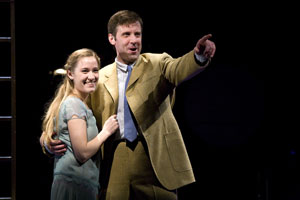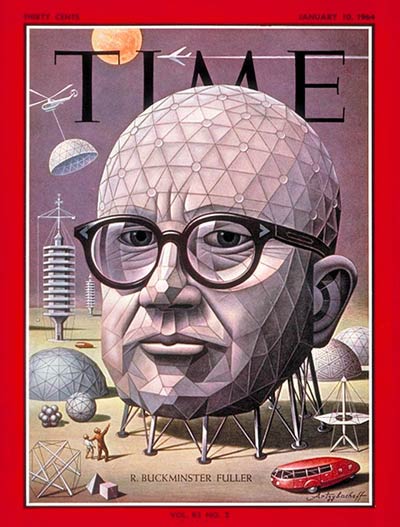I’ve read a couple reviews of Angels & Demons but thus far have not had my most burning question about the movie answered: Will Robert Langdon, Harvard symbologist, once again be forced to face down his old nemesis, claustrophobia, in his scholarly pursuit of truth?
Because I’m pretty much done in by the very idea of Robert Langdon, Harvard symbologist, whenever he appears on the scene in his khakis and his black turtleneck, but once you add in the gripping fear of enclosed spaces — gamely portrayed by Tom Hanks in The Da Vinci Code with gritted teeth and tiny, earnest beads of sweat — it takes it to a whole other level of adventure.
Archives for May 15, 2009
TT: A really, really big show
In today’s Wall Street Journal drama column I report on two first-rate out-of-town shows, Giant at Arlington’s Signature Theatre and Old Times at Chicago’s Remy Bumppo Theatre Company. Here’s an excerpt.
* * *
For some playgoers, the most noteworthy piece of information about “Giant,” Michael John LaChiusa’s musical version of Edna Ferber’s mammoth 1952 novel, will be that it runs for three hours and 45 minutes. Even for an opera, that’s on the long side, and in the knock-’em-dead world of musical comedy, it’s endless. Yet Signature Theatre, which just won a well-deserved regional-theater Tony Award, has thrown caution to the winds and dared to put Mr. LaChiusa’s new show on its smallish stage–with immensely impressive results. This is a long show that doesn’t feel long, with a score so rich and varied that you’ll relish every bar.
 Ferber’s multigenerational middlebrow epic about a family of Texas cattle ranchers is best known nowadays from George Stevens’ star-studded 1956 film version. Sybille Pearson, however, has gone back to the source in writing the book for “Giant,” and her three-act adaptation conveys the essence of the 416-page novel without getting bogged down in Ferber’s flat-textured, tin-eared prose. The story comes through clearly, and it’s a good one, an event-packed tale of a wealthy rancher (Lewis Cleale) whose young Virginia bride (Betsy Morgan), stunned by the size and strangeness of her new home, spends the rest of her life trying to come to terms with Texas.
Ferber’s multigenerational middlebrow epic about a family of Texas cattle ranchers is best known nowadays from George Stevens’ star-studded 1956 film version. Sybille Pearson, however, has gone back to the source in writing the book for “Giant,” and her three-act adaptation conveys the essence of the 416-page novel without getting bogged down in Ferber’s flat-textured, tin-eared prose. The story comes through clearly, and it’s a good one, an event-packed tale of a wealthy rancher (Lewis Cleale) whose young Virginia bride (Betsy Morgan), stunned by the size and strangeness of her new home, spends the rest of her life trying to come to terms with Texas.
The pull of the plot is obviously an important part of what makes “Giant” work on stage, but it’s the marvelous songs that are the heart of the matter. From the spacious, unhurried lyricism of “Lost in Her Woods” to the sock-hop rock of “Jump,” the score of “Giant” cuts a wide swath of stylistic terrain. Yet Mr. LaChiusa isn’t just trying on idioms for size–he is at home in all the musical languages to which he turns his hand–and his plain-spoken lyrics propel the action so decisively that “Giant” seems far shorter than it is….
Time was when Harold Pinter’s shorthand dialogue struck most people as impenetrably mysterious–and times, truth to tell, haven’t changed all that much. Yet his best plays continue to make a powerful impression, and “Old Times,” first seen on Broadway in 1971, has even become something of a regional-theater staple in recent years, partly because it can be produced so cheaply (three actors, one simple set) and partly because it’s so theatrically effective. Pinter never wrote anything more potent than the enigmatic story of Deeley and Kate, an uneasily married couple whose life is disrupted by a visit from Anna, who knew Kate 20 years ago and appears (or maybe not) to have been romantically involved with her. Remy Bumppo Theatre, one of my favorite Chicago companies, is presenting this icy sparring match in an exceptionally satisfying production that has been staged with surgical skill by James Bohnen, the company’s artistic director…
* * *
Read the whole thing here.
TT: The world according to Bucky
 I recently visited a retrospective at Chicago’s Museum of Contemporary Art that was devoted to the life, work, and thought of Buckminster Fuller, the man who invented the geodesic dome and was–once upon a time–famous enough to have made the cover of Time and been profiled in The New Yorker. Fuller isn’t nearly so well known today, but he has his fair share of passionate devotees, and in my “Sightings” column in tomorrow’s Wall Street Journal I take a skeptical look at the sources of their undiminished passion.
I recently visited a retrospective at Chicago’s Museum of Contemporary Art that was devoted to the life, work, and thought of Buckminster Fuller, the man who invented the geodesic dome and was–once upon a time–famous enough to have made the cover of Time and been profiled in The New Yorker. Fuller isn’t nearly so well known today, but he has his fair share of passionate devotees, and in my “Sightings” column in tomorrow’s Wall Street Journal I take a skeptical look at the sources of their undiminished passion.
Exactly what was it about this self-styled “comprehensive anticipatory design scientist” that made so many people so sure that he knew the secret of peace, love, and understanding? For the answer, pick up a copy of Saturday’s Journal and see what I have to say.
UPDATE: Read the whole thing here.
TT: Almanac
“The critic lives at second hand. He writes about. The poem, the novel, or the play must be given to him; criticism exists by the grace of other men’s genius. By virtue of style, criticism can itself become literature. But usually this occurs only when the writer is acting as critic of his own work or as outrider to his own poetics, when the criticism of Coleridge is work in progress or that of T.S. Eliot propaganda.”
George Steiner, Language and Silence
